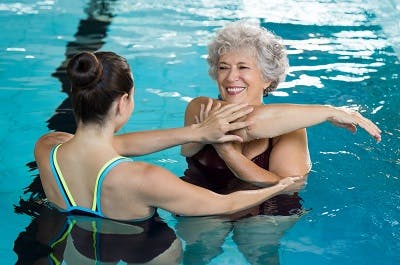A spinal cord injury causes loss of motor control and sensation which can make it challenging to stay physically active. However, with an open mind and willingness to adapt, you may be surprised to discover that you can still participate in many engaging activities after a spinal cord injury.
To help you develop a better idea of how individuals can incorporate more physical activity into their lives after SCI, this article will share 5 activities for spinal cord injury patients and their therapeutic benefits.
Best Activities for Spinal Cord Injury Patients
Depending on the level and severity of injury, participating in activities involving physical movement after a spinal cord injury can be challenging. However, it is important for individuals to regularly engage in active tasks to promote improvements and/or maintain current functions.
Every movement stimulates the spinal cord, which can help promote adaptive changes in the central nervous system. When there are existing neural pathways left intact at the level of injury, as is the case with incomplete spinal cord injuries, working on improving strength and motion in the affected areas of the body may lead to functional improvements. Among individuals with both complete and incomplete spinal cord injuries, higher physical activity levels can also help improve circulation, mood, sleep, and many other essential bodily functions.
Below is a list of some of the best activities for those with spinal cord injuries. However, this is not a conclusive list. Ultimately, you should participate in activities that you enjoy because those are the ones that will encourage the most movement in the long-term.
1. Go to the Pool

Practicing movements in a pool is an excellent activity for spinal cord injury patients because water provides buoyancy. Buoyancy is the upward force exerted onto any object submerged in water. This is what makes you feel weightless when you’re in a pool.
As a result, individuals with spinal cord injuries can practice walking without placing too much pressure on their joints. Additionally, the natural resistance of water can help strengthen and tone the muscles.
Further benefits include improved circulation from the pressure of water on the body, as well as loosened muscles and pain relief if exercising in warm water.For a more intense pool activity, consider trying water aerobics. Start by working with a physical therapist in the pool (aquatic therapy) to learn safety tactics before attempting this on your own or with a local group.
2. Practice Yoga
Following a spinal cord injury, communication between your mind and body gets disrupted. A primary focus of yoga is finding the connection between your mind and body, which makes it an ideal activity for spinal cord injury patients.
Additionally, yoga can be modified so that individuals with paralysis can safely participate in it. For example, the exercises can be performed from a wheelchair or on the floor. Furthermore, most yoga practices emphasize moving within your own limits, which can encourage individuals with varying physical abilities to participate.
There is also a large mental component to yoga, which may involve visualization, mindfulness, and/or meditation. In fact, studies have shown that practicing yoga can help individuals with spinal cord injuries reduce depressive symptoms and improve self-compassion, in addition to improving functional outcomes.
3. Try Adaptive Sports
Individuals with spinal cord injuries who were previously very active may miss participating in recreational sports. Adaptive sports provide an excellent way for both children and adults alike to participate in team or individual sporting events, such as wheelchair basketball, wheelchair tennis or adaptive track and field.
In addition to the physical benefits of adaptive sports, individuals may also experience psychosocial benefits from being part of a team and meeting others with similar life experiences. Studies have also shown individuals with spinal cord injuries who participate in adaptive sports report an improved quality of life.
Recently published guidelines on physical activity levels for adults with spinal cord injuries recommend at least 20 minutes of moderate to vigorous intensity aerobic exercise, as well as 3 sets of strength exercises for each major functioning muscle group, twice per week. Joining an adaptive sports team could be a great way to start working toward that goal.
Check with your local hospital or a nearby rehabilitative hospital to learn more about adaptive sports opportunities in your area.
4. Create Artwork
Individuals with more severe higher level injuries may have a hard time participating in many physical activities. However, creating artwork can be a great way to maintain and build muscle while also expressing oneself. There are many adaptations individuals can use, allowing almost anyone to create works of art.
For example, individuals who have lost use of their arms and hands could paint by holding a paintbrush in their mouth, or on a computer with an eye gaze device. Those who have limited hand movement could use a paintbrush with a larger handle or attach the paintbrush to a universal cuff. Painting on an easel can allow individuals to work on shoulder motion and strength, while creating a smaller, intricate painting can help individuals practice and perfect fine motor precision.
Other forms of artwork, such as molding clay or woodworking, can help individuals build fine motor strength. If you feel comfortable, consider joining a local art group. Since art is such a wide, subjective field, the possibilities are endless.
5. Practice Exercises with FitMi

Gamified rehabilitation devices, such as the FitMi Home Therapy Program, are gaining popularity. Practicing exercises with FitMi is an excellent way to encourage physical activity for individuals with spinal cord injuries.
By interacting with sensorized pucks, individuals are challenged to accomplish a certain number of repetitions within a given time frame. FitMi can even adapt to your ability level, and it can track your progress to show where you’ve improved.
With 40 therapist-recommended exercises that target the hands, arms, core, and legs, FitMi is an ideal rehabilitation device for individuals with any level of spinal cord injury.
Learn more about FitMi Home Therapy »
Additional Activities for Spinal Cord Injury Patients
The activities outlined above are simply the tip of the iceberg. Other beneficial and engaging activities for spinal cord injury patients may include:
- Horseback riding: Horseback riding can be very beneficial for individuals with lower-level or milder injuries. Some individuals may even choose to participate in horseback riding through hippotherapy for personalized recommendations on how to work toward managing leg spasticity, gaining core strength, and improving balance.
- Musical pursuits: Some individuals, especially those with cervical spinal cord injuries, experience respiratory difficulties. Practicing singing can be a great way to exercise the muscles involved in respiration. Dancing, playing the drums, or walking in rhythm to a song are other ways that music can promote physical activity for spinal cord patients.
- Archery: One of the first sports to be used as a remedial exercise for individuals with paraplegia, archery trains the arms, shoulders, and trunk muscles, which is proven to help restore the ability to sit in an upright position with little to no support. Those who lack sensation in the upper body can also participate in archery by using a specialized glove or extension splint.
As you adjust to life after a spinal cord injury, it may be challenging to visualize yourself participating in some of your favorite activities. With adaptations and modifications, many activities are possible for individuals with spinal cord injuries. If you’re having trouble, talk with your occupational therapist about specific activities and/or adaptations that may be best for you.
What Are the Best Activities for Spinal Cord Injury Patients?
The best activities for spinal cord injury patients are the ones that they’ll actually want to do!
You may need to adjust how you do it, but a spinal cord injury should not discourage you from participating in all your favorite activities. Participating in the activities you love will help you stay positive and relieve stress after spinal cord injury.
We hope you explore some of the activities shared in this article to promote your SCI recovery.
The post Activities for Spinal Cord Injury Patients That Promote Recovery appeared first on Flint Rehab.



